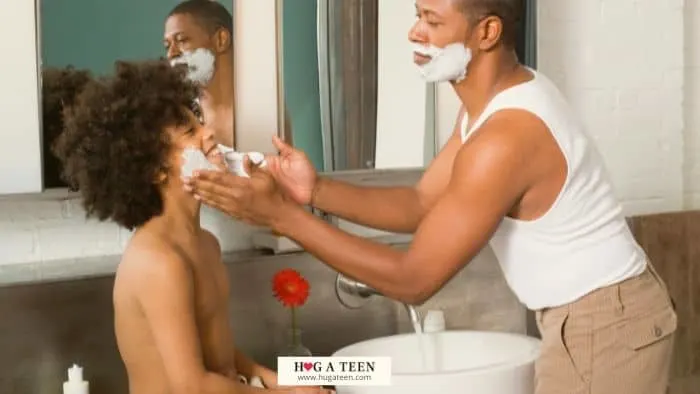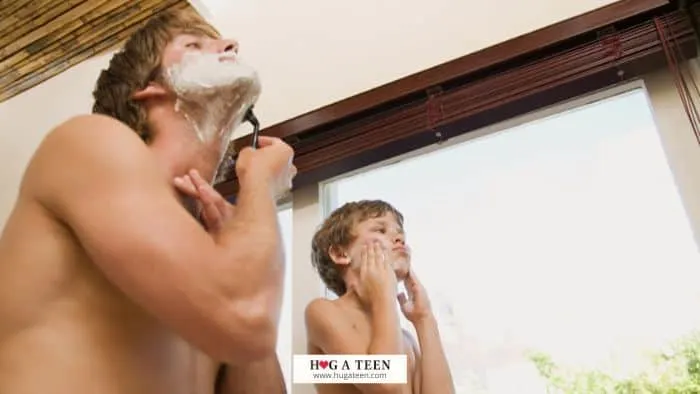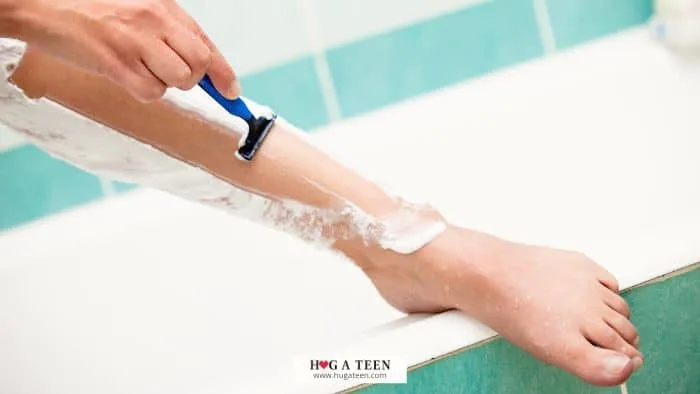Once body hair starts to grow and become visible, your teen will probably come to you and ask if they can shave.
Teaching your kid to shave can be a great opportunity for moms and dads to have a bonding moment with their teens.
Talk to your child and find out why they want to start shaving, explain to them why they might want to wait, and if they’re ready, get them the tools and knowledge to shave properly.
There’s no medical reason why teens should or should not shave once they have visible hair and would like to get rid of it.
This article highlights how to teach a kid to shave with shaving tips and tools that a first-time shaver can use.
- How To Teach Your Son To Shave
- At What Age Do Boys Start Shaving?
- How Often Should My Son Shave?
- When Should A Boy Start Shaving His Mustache?
- How To Shave For Beginners Girl
- How To Teach Daughter To Shave Legs
- How To Teach Your Daughter To Shave Her Armpits
- Best Razors For Teens
- Can I shave my upper lip with a razor, girl?
- Should I let my 11-year-old shave her legs?
- Why do moms tell daughters not to shave above the knee?
How To Teach Your Son To Shave

Teaching your son to shave is an important milestone in his journey to adulthood. It can be a little daunting, but with patience and guidance, you can help him develop the skills and confidence he needs to shave safely and effectively.
The best way to teach your kid to shave for the first time is to show them and do it with them.
Here is a step-by-step guide to teaching your son how to shave:
Step 1: Discuss Shaving Basics
Before you start teaching your son to shave, it’s essential to discuss the basics of shaving. Explain to him that once you start shaving, the hair will grow back thicker and coarser. The fluffy hair that he has on his face will soon become harder stubble.
You can also discuss the different types of razors, shaving creams, and aftershave lotions. Make sure he understands the importance of using sharp and clean blades and maintaining good hygiene practices.
Step 2: Show the Different Parts of the Face
Next, show your son the different parts of his face where he might need to shave. These areas usually include the cheeks, chin, upper lip, and neck. Explain how the direction of hair growth can vary in different parts of the face and how this can affect the shaving process.
Step 3: Select the Right Razor
Help your son select the right razor based on his skin type and the thickness of his facial hair. Disposable razors or cartridge razors are generally the best options for beginners. Electric razors can also be a good choice, but they may require more practice to get the desired result.
Step 4: Prepare the Face for Shaving
Before your son starts shaving, it’s crucial to prepare his face properly. The best time to shave would be after a shower. Alternatively, the face should be washed and cleaned, preferably with warm water. The water relaxes the hair follicles and lubricates the skin, allowing a smoother shave.
It is essential to clean and prepare the skin to eliminate impurities or germs that might have settled on it. If there are cuts or nicks during shaving, the germs might get into the open wounds and cause skin infections.
Once cleaned, apply a shaving cream or gel to the areas that need to be shaved. Make sure he applies enough shaving cream to cover the entire area but not so much that it clogs the razor.
Step 5: Demonstrate Shaving Techniques
Now it’s time to demonstrate the shaving technique. Start by showing your son how to hold the razor correctly and how to shave with the grain of the hair growth.
Remind him to shave in slow and smooth strokes, rinsing the blade with cool water frequently to prevent clogging. He should rinse the blade after every 2-3 strokes. It helps remove the lather and hair stuck on the edges.
It’s also essential to remind him not to apply too much pressure and to let the razor glide over the skin. Without pressing the razor, gently glide the razor with strokes going downwards from top to bottom in the direction of hair growth.
There should be no folds on the skin; pull the skin gently to ensure the area is flat to reduce the risk of nicks.
After use, he should rinse the razor under running water. Lightly tap the razor on the sides of the sink, removing hairs stuck on the blades, and wipe with a towel to dry.
Step 6: Teach Post-Shaving Care
After your son has finished shaving, it’s important to teach him how to take care of his skin properly. First, he should rinse his face with cold water to close the pores.
Then, he should apply aftershave balm to soothe the skin and prevent razor burn or irritation. The best are alcohol-free, with aloe vera, made for sensitive skin, and with a mild scent.
If he has a cut, he can blot it with some clean paper or apply Vaseline to make it stop bleeding.
Step 7: Provide Guidance and Supervision
Most young boys cut themselves when they start shaving. If one gets cuts, you can apply a mineral block which will dry out the area and act as an antiseptic. With time and after several shaves, they usually become better at it.
Provide guidance and supervision as your son practices his shaving technique. Encourage him to take his time and be patient with the process. It’s also important to remind him to replace the razor blades regularly and to maintain good hygiene practices.
Teaching your son to shave is an important milestone that requires patience and guidance. By following these steps, you can help your son develop the skills and confidence he needs to shave safely and effectively.
🤓 Suggested reading: How To Grow A Beard As A Teenager (15 Actionable Tips)
At What Age Do Boys Start Shaving?
Boys can start shaving when they start getting visible facial hair. This can vary depending on a number of factors, including genetics, ethnicity, and hormonal development. However, most boys will begin to develop facial hair during puberty, which typically occurs between the ages of 9 and 14.

Boys will start growing facial hair in the following order:
1. First, the upper lip
2. Then sideburns
3. Next chin
4. Followed by cheeks
5. And lastly, on his neck
👉 You might also enjoy reading: What Are Teenage Beard Growth Stages?
It’s important to note that not all boys will start shaving at the same age. Some may need to start shaving earlier than others, while some may not develop enough facial hair to require regular shaving until later on in their teenage years.
Ultimately, the decision on when to start shaving should be left up to the individual, based on their personal preference and the amount of hair growth they have.
It’s always a good idea to have an open and honest conversation with your son about shaving and offer guidance and support when they’re ready to start.
In some schools, it is required and indicated by the grooming policies in the institution. To abide by these regulations, some boys begin shaving earlier than others.
How Often Should My Son Shave?
The frequency depends on how fast his hair grows back and if it bothers him. If he has dark or thick hair and he doesn’t like how it feels or looks, then he might need to shave a few times a week.
However, if he still has ‘peach fuzz’ then he might have to shave only once every few weeks when the hair has grown long again.
When Should A Boy Start Shaving His Mustache?
A boy can start shaving his mustache as soon as it becomes noticeable and bothers him. Hair on the upper lip tends to grow first before other facial hair.
The first facial hair is more fluffy, and it’s a personal preference whether he’d want to shave this off immediately or let it grow a bit thicker.
Be sure to explain to your son that once he starts shaving, the fluffy hair will start growing back thicker and become more stubbly in time.
It will be best to use a special razor for sensitive skin, like a Gillette Skinguard Sensitive razor for younger skin, as these blades are designed to minimize pressure and protect the skin.
Watch this video on how to teach your son how to shave for the first time:
How To Shave For Beginners Girl

Shaving is a personal choice that many girls make as they start to develop hair in different areas of their bodies. Whether you want to shave your legs, armpits, or pubic area, it’s essential to learn how to do it safely and effectively.
The best way to teach your daughter how to shave for the first time is to show her and do it with her.
Here’s a step-by-step guide on how to shave for beginners girls:
Step 1: Choose the Right Razor
The first step in shaving is to choose the right razor. There are many types of razors available, from disposable to electric, so you’ll want to choose one that you’re comfortable using. If you’re a beginner, it’s usually best to start with a disposable razor with a moisturizing strip and multiple blades for a smoother shave.
Step 2: Prepare the Skin
Before shaving, it’s important to prepare the skin properly. Take a shower or bath to soften the hair and skin, making it easier to shave. If you don’t have time for a shower, you can wet a washcloth with warm water and hold it against the skin for a few minutes.
Step 3: Apply Shaving Cream or Gel
Next, apply shaving cream or gel to the area you want to shave. Make sure to use a shaving cream or gel that’s designed for women to prevent irritation. Apply a thin layer of shaving cream or gel to the area, ensuring that it’s evenly distributed.
Step 4: Shave the Area
Once you’ve applied the shaving cream or gel, it’s time to start shaving. If it’s her first time shaving then the hair will probably be fluffy and longer. It’s best to shave in the direction of hair growth to start. Don’t apply too much pressure or shave over the same area multiple times, as this can lead to razor burn or skin irritation. Rinse the razor frequently to remove hair and shaving cream buildup.
Step 5: Pull the skin taut
Always ensure you pull your skin taut when shaving to avoid nicks.
If shaving under the arms, lift your arm up and shave downwards with gentle strokes.
When shaving legs be especially careful around the ankles and knees to avoid knicks. Shave slowly around these areas to avoid cutting on the boney areas.
You can reapply shaving cream and shave against the hair follicle to get a closer shave once the longer hairs on your legs have been removed.
Step 6: Rinse and Moisturize
After you’ve finished shaving, rinse the area with cool water to close the pores and prevent irritation. Pat the area dry with a clean towel and apply a moisturizing lotion or cream to soothe the skin. Avoid using products with alcohol or fragrance, as they can cause further irritation.
Step 7: Be Gentle and Patient
Remember that shaving takes practice, and it may take some time to perfect your technique. Be patient and gentle with your skin to avoid cuts or irritation. If you experience redness, bumps, or ingrown hairs, try using a gentle exfoliating scrub to remove dead skin cells and prevent further irritation.
Step 8: Replace blades when dull
If the blade seems to tug on the hair during a shaving session, or you get cuts, it simply means it’s time to get a new razor. Razors should be replaced after 5 – 10 uses. Some razor blades have a moisture strip which indicates when it’s time to replace your razor. Using an old razor with dull blades can be extremely painful and cause ingrown hairs.
Razors are meant for an individual user. It’s unsafe and unsanitary to share razors among members of the same family. Shaving kits are available in different colors and designs; a girl can choose one that suits her and does the job well.
How To Teach Daughter To Shave Legs
When teaching your daughter to shave her legs, there are a few important tips to keep in mind to ensure that she gets the best possible results and avoids any skin irritation or injury.
Here are some key tips to mention:
Choose the right razor: Encourage your daughter to choose a razor that’s designed for women and has multiple blades and a moisturizing strip to help prevent irritation.
Prepare the skin: Softening the skin and hair before shaving is crucial to getting a smooth, clean shave. Have your daughter take a warm bath or shower before shaving, or apply a warm, damp washcloth to the skin to help open up the pores and soften the hair.
Use shaving cream or gel: Applying a shaving cream or gel to the skin helps the razor glide smoothly and reduces the risk of nicks or cuts. Make sure your daughter uses a product that’s designed for women and has a moisturizing formula to prevent irritation.
Shave in both directions of hair growth: Shaving against the grain i.e. up the leg, increases the risk of cuts, irritation, and ingrown hairs. However, it also gives a much closer shave. It’s probably best to first shave down the legs (in the direction of hair growth) first. Once your leg hair is shorter, you can reapply more shaving gel and shave against the grain to get a closer shave.
This will mean that the hair growth will take a bit longer to be visible, and therefore you won’t need to shave as often. However, if you have very sensitive skin, you should probably just shave down the leg to avoid razor burn or irritation.
Encourage your daughter to use light, gentle strokes and rinse the razor frequently to prevent buildup. The areas to look out for to avoid getting cuts are the ankles and around the knees. You should save more slowly and apply less pressure to these areas.
Rinse and moisturize: After shaving, encourage your daughter to rinse the skin thoroughly with cool water to close the pores and help prevent irritation. Then, she can apply a moisturizing lotion or cream to soothe the skin and prevent dryness.
Replace the razor regularly: A dull or worn-out razor can cause irritation and nicks, so make sure your daughter replaces her razor regularly, especially if she shaves frequently.
Take it slow: Shaving takes practice, so encourage your daughter to take her time and be patient. Remind her that it’s okay if she doesn’t get a perfect shave the first time and that she can always try again later.
By following these tips, your daughter can achieve a smooth, clean shave and avoid any skin irritation or injury. Encourage her to be gentle with her skin and take her time, and she’ll soon become a pro at shaving her legs.
Watch the video below where mom Bonnie teaches her daughter Olivia how to shave:
How To Teach Your Daughter To Shave Her Armpits
When shaving for the first time, you could choose to use a trimmer first as the hair will be longer. Once trimmed, she can use a good-quality razor. She should lift her arm up to make the skin taut and ensure the area is flat. Chances of cutting herself are reduced if there are no skin folds. Be sure to use a shaving gel for a smoother shave.

When should a girl start shaving her armpits?
A girl can start shaving her armpits when she has visible hair under her arms, and she feels that she wants to and is ready. It is a personal choice. The best way to approach the subject would be by talking to your daughter and understanding her feelings regarding her developing body and what she needs and requires to feel more confident.
Girls will start developing pubic hair first and then armpit hair. Although she does not have to shave, she might want to shave if her friends do, and she may feel that it is more hygienic.
Not everybody chooses to shave their armpits, although most teenagers will probably want to try it at some point, mainly due to other girls shaving as well. Support your daughter in whatever she chooses.
🤓 Suggested reading: Best Natural Deodorants For Kids And Teens
Best Razors For Teens
Razors recommended for teens are safety razors. Cartridge razors with few blades are also okay to use. The hair on most teens has low density; a mild razor with mild blades will work just fine. It is unsafe and unsanitary to share razors among members of the same family.
Best Safety Razor For Beginners Girl
Gillete Venus Tropical Disposable Razors
Includes:
- 3 x flexible blads
- Soft grip handle
- Tropical scented handles
- Lubrastrip for glide
Comes in multiple colors with scented handles providing a smooth close shave with three curving blades that maneuver easily with the curves of a woman’s body. The handles provide an enjoyable fresh, topical shaving experience.
Best Hybrid Electric Razor For Teen Boys
Philips Norelco OneBlade First Shave teen shaver
Includes:
- First teen shave
- Hybrid Electric Shaver
- Coated anti-friction blades
- Battery powered
- Includes charger
- Wet or dry shave
- Blade lasts up to 4 months (2 full shaves per week)
Ideal for long hair with great speed, giving a fast, clean shave. It has a protective plate on top of the blades to protect the skin from cuts and nicks. It has a layer of micro-glass beads to reduce friction while shaving and razor burns.
Best Electric Shaver For Teenage Girl
Philips SatinShave Women’s Wet & Dry Electric Shaver
Includes:
- Wet or dry use
- Cordless battery powered
- For sensitive skin
- Hypoallergenic foil
Ideal for sensitive skin due to its hypoallergenic blades, which also reduce irritation. Great for quick dry shaves and lengthy shaves in the shower with a shaving gel. Designed to glide smoothly and gently over the contours of the body.
Best Electric Shaver For Teenage Boy
Philips Norelco Shaver 2300
Includes:
- Battery powered
- Electric shaver
- ComfortCut Blades
- Heads flex and float in 4 directions
- Pop-up trimmer for mustache & sideburns
- Easy cleaning
- 40 min of cordless shaving from an 8-hour charge
The Philips Norelco Shaver has sharp blades that cut smoothly and produce a close shave like an actual straight-edge razor. The battery is long-lasting and recharges quickly. Maneuvers easily around the curves of the face and tricky spots.
If you apply too little or too much pressure, it changes color to let you know. This indicator helps reduce irritation to the skin. It also indicates the battery charge left.
Can I shave my upper lip with a razor, girl?
You can shave your upper lip with a razor to eliminate the hair. It is always advised to shave up and down and never go sideways. Make sure the skin is tight; it’s easier and less painful than shaving loose skin.
Although you can shave your lip, the hair that grows out will have a blunt tip, meaning that it will feel more coarse and stubbly.
The alternatives to shaving your lip include:
- Waxing
- Depilatory creams
- Lip threading
- Upper lip bleaching
- Laser hair removal
Should I let my 11-year-old shave her legs?
Whether or not to let an 11-year-old shave their legs is a personal decision that ultimately depends on a number of factors, including cultural and familial norms, personal preferences, and the maturity level of the child.
Some girls may begin to develop hair on their legs earlier than others and may feel self-conscious or uncomfortable about it. If your child expresses an interest in shaving their legs, you should be open to discussing it with them so that they learn the correct way to shave from you and not go to their friends for advice instead.
My mother would not let me shave my legs when I was 13 because she didn’t think it was necessary and was worried that it would grow back more stubbly.
All the girls were shaving at school, and I felt so embarrassed. Eventually, my boyfriend bought me a shaving kit, as he listened and understood what I was feeling. I tried to hide it from my mother as long as possible. I would have much preferred if my mother had shown me how to shave instead of having to go behind her back and try to teach myself.
Shaving should be a personal choice, and there’s no right or wrong age to start. However, it’s important to ensure that your child is physically and emotionally ready to handle the responsibility of shaving safely and effectively.
Make sure your child understands the basics of shaving and is able to follow proper hygiene practices, such as using a clean, sharp razor and moisturizing the skin afterward.
Encourage your child to take their time and be patient, and offer guidance and supervision as needed. Ultimately, the decision on whether or not to let your 11-year-old shave their legs is up to you as a parent and should be based on what you feel is best for your child.
However, there is no medical harm in her getting rid of leg hair. Some feel uncomfortable if the hair is too visible, and by shaving, get more confident. Nothing wrong with a little confidence boost.
Why do moms tell daughters not to shave above the knee?
Firstly, the hair above the knee is typically lighter and less noticeable than the hair on the lower leg, so shaving may not be necessary for everyone. Clothes usually cover a large area above the knees, so if there are any hairs, the possibility of them being seen is minimal.
Additionally, the hair may grow back thicker and darker.
Furthermore, the skin above the knee is more sensitive and prone to irritation or injury from shaving, which can be uncomfortable or painful.
Ultimately, whether or not to shave above the knee is a personal choice that should be based on individual preferences and comfort levels. While some moms may advise against it, others may encourage their daughters to do what makes them feel confident and comfortable in their own skin.




